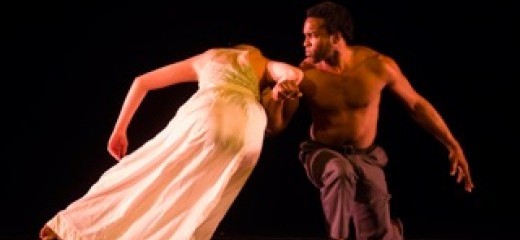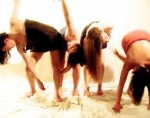
Cool Dancing in Warm Spaces
by Lisa Bardarson
Myra Bazell, a much-loved teacher of dance, and Jane Gotch first met fifteen years ago when Gotch had to scratch together enough change to take Bazell's popular modern class. The good-vibe feeling between these two choreographers was evident as Bazell explained to the audience of about thirty on a (thankfully) not-too-hot June evening that the Iron Factory was a positive venue for this reunion.
During Bazell's ISEEISAW, featuring the fine dancing of Eleanor Goudie-Averill, Grace Stern and Elizabeth Weinstein, I wondered whether these three were representing one or two characters at different life stages. The piece opened with Stern, sitting on a bench placed upstage, and Goudie-Averill and Weinstein on opposite sides of the space. A scratchy recording of a 30's-era song created an air of nostalgia. Goudie-Averill and Weinstein traced large running circles in the space until they collided with a jarring S*M*A*C*K!!!--their bodies connecting with the attraction of two magnets. Moving in unison, they then mirrored one another as the lone dancer on the bench gazed off in the distance as though reminiscing about the very scene being danced.
The dynamic forces of love and tenderness, fear and sadness seemed to be at the root of this piece, and the pronounced use of the dancers' upwardly thrust rib cages made them look as though their hearts were trying to burst through in a desire to connect. I can't prove that this was the case--there were no garish gestures suggesting this, merely a culmination of their separate and combined actions that seemed to subtly communicate their unseen bond. At the dance's conclusion, I had a lump in my throat and a rising well of tears. I didn't see this emotional Ninja coming. What a rare experience that was.
By the time Gotch's dance began, this intimate performance space was ripe with the scent of sweating bodies. The windows were thrown wide open, and the sound of evening birdsong and street noise drifted in. These sultry details added to the intimacy of Gotch's Let It Fall, a duet for Leo Gayden and Juliet Remmers that highlighted their different ethnicities. Gayden, who is African American, drew on the vernacular of hip-hop, and Remmers, who is Caucasian, danced with inflections of "white" modern/post-modernism.
Gayden, shirtless, began the dance with a terse, repetitive motif that was bound and laborious. With a fierce gaze, he barely moved off of his downstage mark, leaving me with an impression of entrenchment and entrapment.
Remmers, serving as both puppet and puppeteer, tugged and pulled on an invisible string while singing Schubert. (If I was controlled by invisible strings, I would probably sing Schubert's words too: "My peace is gone, My heart is heavy, I will find it never and never more. Where I do not have him, That is the grave, The whole world is bitter to me.") Gayden shadowed Remmers as she sang this and then enveloped her. A flowing, lustful lift burst out of their intimate proximity and it was a relief of recognizable union. Up until then, their relationship had been unclear, enigmatic. This dance contained man/woman, black/white, afro/euro-culturism and the universality of the oppression that lives in all societies.
In the final tableau, Remmers, who stood next to the kneeling Gayden, gently placed her hand on his shoulder as if to say, "Stay put." This troubling gesture, coupled with their different races and height disparity, left me uncomfortably wrestling with the sordid legacy of my American heritage and wondering if this was the intended message.
Myra Bazell/Scrap Performance Group and Jane Gotch, The Iron Factory, June 13 and 14.
By Lisa Bardarson
July 7, 2014








